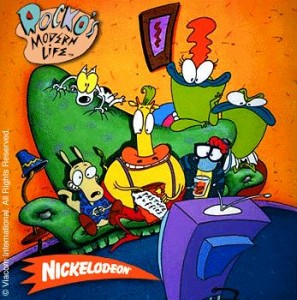Archive for March, 2010
Joe Murray, Betty Boop, and Free-Range Animation
Posted by kjohnson1585 in Film, Television, Uncategorized, Writing on March 12, 2010
I really empathize with Joe Murray.
The creator of Rocko’s Modern Life debuted his titular cartoon on Nickelodeon right as the true face of the internet began to take form; the geekiest among us refer to it as “Eternal September.” While the fresh-faced newcomers to the “World Wide Web” aggressively staked their claim in chat rooms and Usenet boards, Murray was simply content to create a funny, wacky show that pushed boundaries once in a while. The boundary-pushing was merely an afterthought, though; and it took a while before Nickelodeon’s network executives became wise to the game, and seriously curtailed the consistent attempts at crude and gross humor. It’s obvious how the show seemed to calm down its more grotesque elements as the seasons went along: bits with brain removal; board games involving “monkeys” and “whacking paddles;” Heffer, a steer, being milked into what is clearly sexual orgasm – all these seem to disappear towards the latter episodes.
Truth be told, moments like that were far and few in between. But as the show was wrapping up, the INTERNET, with its uncanny love of all things gross, weird, and disturbing, hailed Rocko’s Modern Life as some brilliant takedown of the man and the state of animation as they knew it. It was Invader Zim before Invader Zim was Invader Zim (a cartoon I will be discussing very, very soon).
Don’t get me wrong. Rocko’s Modern Life was definitely a brilliant show, but hardly because of how clever it got away with its shady humor. (FYI, as far as I’m concerned, shady humor is simply humor with a dirty face. I don’t care how much blood, sex, or violence is involved, as long as its funny.) Rocko’s Modern Life was brilliant in its classical embrace and subversion of animation styles and tropes not witnessed since the 1930s, the early days of Betty Boop. Many claim that Ren and Stimpy had a strong influence on Rocko’s Modern Life (like so many modern cartoons), but Max Fleischer’s style has a larger hand in the visual aesthetic and physical gags. That bizarre curvature to Rocko’s world seems to be a callback to the “roundness” and “bounce” of classic black and white animation, and a number of the jokes emphasized that free-range style where objects, literally, come alive – a style that many viewers are disturbed by, mainly because they aren’t quite used to it.
This “free-range” animation should not be confused with Surreal Animation, although they are closely related. Surreal Animation, like the paintings of Dali or the films of Bunuel, emphasize dream-like, or altered states, which, to put it bluntly, pretty much asked its viewers to be high. Free-range animation had no such obligation (although its clear that being high is perfectly acceptable); it simply understood and embraced the full activity of animation, and sought to really ANIMATE the fame, in every possible sense of the word.
Betty Boop is a great example of this. Betty Boop, Max Fleischer’s darling creation in the 1930s, was the masculine epitome of idealized femininity: sweet, innocent, “sexy,” and consistently happy. No matter that the nation was hugely in debt and a global threat loomed over the horizon, Boop’s happy-go-lucky temperament was always intact. The important thing, however, is that Boop did not exist in a world that paralleled our Depression-addled society. Betty’s world was just as happy and free-range as her personality, so much so that it seemed physically designed to curry to her favor. The world would “come alive,” at will, at random, if to assist in helping Boop in anyway it could.
And so, we would see statues and flows anthropomorphize themselves temporarily to console, dance with, or otherwise chat with Boop as she went through her trials and tribulations. She bounced, and the world bounced with her; she cried, and so did everyone else. The animated world of Boop had no limits, and it’s something of a lost art to play so fast and loose with the medium itself.
Rocko’s Modern Life did, albeit in a different fashion. While Boop’s world was idealistically optimistic towards her overall happiness, Rocko’s world was cruel, mean, and crass. One of my favorite gags involved Rocko, while on a skiing trip, choking a bush in anger that was in his way. The trees around him come alive and proceed to attack him in retaliation. But the gag doesn’t end there. When Rocko ends up in the hospital by the end of the episode, the nurse in the lobby directs the same trees to his room (she confuses them for Rocko’s parents). It’s such an amazing gag, and it’s only now that I’ve begun thinking about the joke’s structure.
Rocko’s world was a free expanse of living-at-will objects: trees protecting its own, vacuum cleaners coming alive and eating people, chairs wanting to be sat upon. It’s VERY weird – uncanny even – without a general understand of, or at least exposure to, classic Fleischer animation.
You can see the departure from the free-range to the traditional in Camp Lazlo, a much more streamlined, character-based cartoon. The internet didn’t have its grossed out, surrealist, and/or free-ranged oddness, so it chalked up Camp Lazlo to generic lameness. The humor, however, was still as great as Rocko’s Modern Life was, just more or less regulated to character-based gags than medium-based. Still, I adored Camp Lazlo and truly wished the world did as well.
Most modern cartoons are indeed influenced by Ren and Stimpy, and while that’s to be expected, I have to admit that Murray’s attempt to utilize animation tropes not used since the 30s is rather admirable… and ballsy. Murray has a great sense of comedic time and visual wit, and he uses it excellently, whether he utilizes this free-range animation style or not. Check out a clip from his new, upcoming short.


